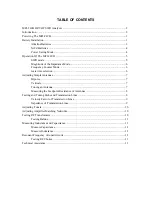
MFJ-249B Instruction Manual
HF/VHF SWR Analyzer
5
OPERATION OF THE MFJ-249B
Some understanding of transmission line and antenna behavior is necessary in order to use the
MFJ-249B properly. For a thorough explanation the ARRL Handbooks or other detailed books
can be used for reference.
The
ANTENNA
connector (SO-239 type) on the top of the MFJ-249B provides the measurement
bridge output connection. To measure SWR or any impedance, this connector must be connected
to the load or device under test.
WARNING:
Never apply power to the antenna connector !
To measure the SWR or any impedance, on a predetermined frequency adjust the
TUNE
and
FREQUENCY
knobs until the counter displays the desired frequency.
By pressing the
MODE
push button seven different operation modes are selected. The unit can
measure on any frequency from 1.8 to 170 MHz.
The frequency counter will display a maximum of five digits. This will produce an entirely
stable reading of the internal oscillator short term drifted signal.
SWR mode
The unit enters the
SWR
mode when it is turned ON. The MFJ-249B will measure the standing
wave ratio (SWR) of any load referenced to 50 ohms. To measure the SWR of a 50 ohm coaxial
line simply connects the line to the
ANTENNA
connector. The display will show the selected
frequency and the actual SWR in a numerical and a bar graph format. The maximum numerical
SWR displayed is
25.
Any SWR adjustments have to be made at the antenna, since any adjustments at the transmitter
end of the feedline can not affect the losses, nor the efficiency of the antenna system.
The bar graph scale is as follows:
SWR
:
1 1.1 1.2 1.3 1.4 1.5 2 3 4 5
6
7
8
Bar graph:
[1] [2] [3] [4] [5] [6] [7] [8] [9] [10] [11] [12] [13
]














